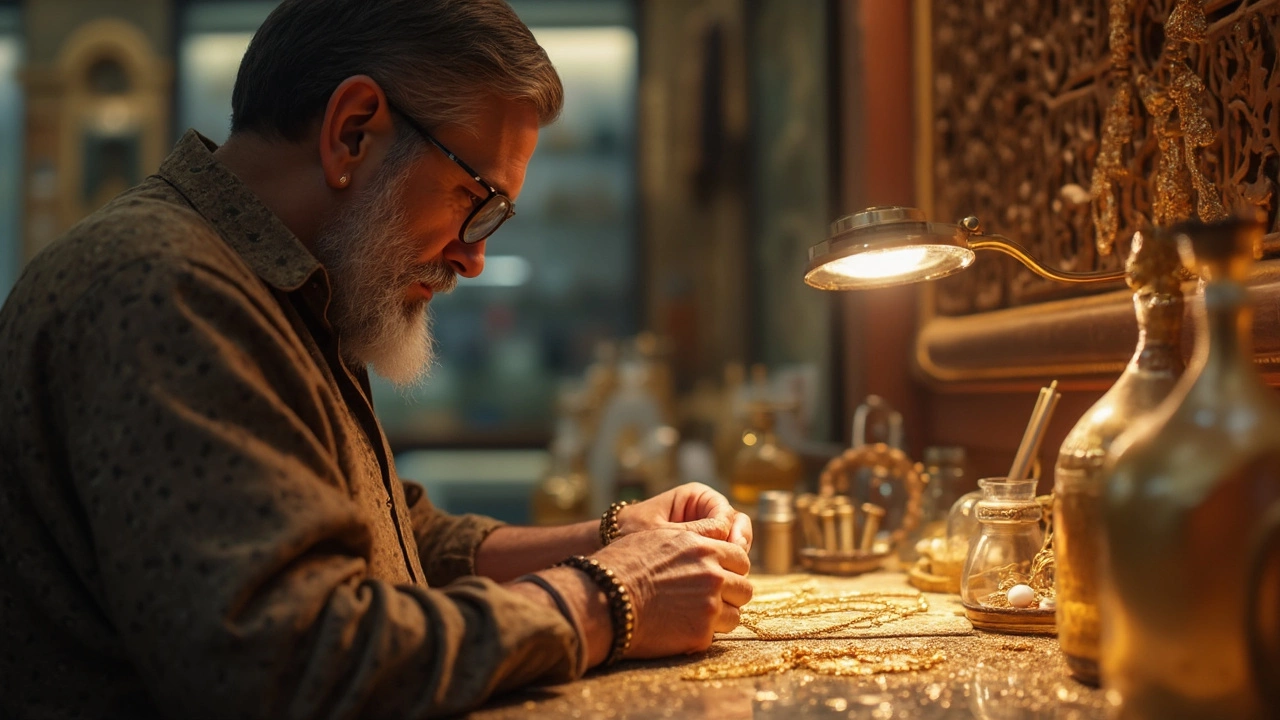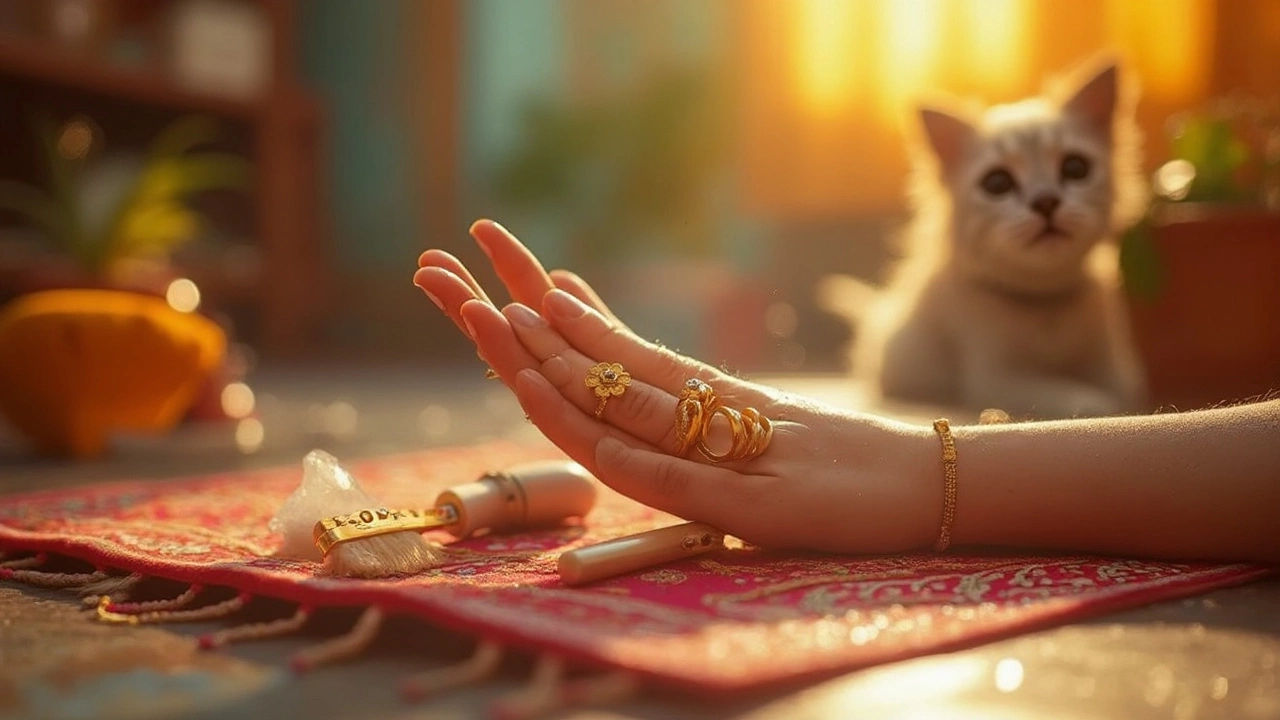White gold jewelry starts out shiny and almost silvery, but over time, you might notice it turning yellow. This isn’t just dirt or regular wear—it actually has to do with how white gold is made. If you’ve spent good money on rings or chains, seeing them lose their sparkle stings a bit.
Before you panic, here’s the real reason: white gold is basically regular gold mixed with other metals, then covered with a super-thin layer of rhodium. That top layer makes it look bright white, but it’s not permanent. Everyday stuff like hand soap, sweat, or even just normal wear can wear it off. Once that rhodium wears thin, the natural yellow tone underneath starts to peek through.
So, what can you do when your white gold takes on that unwanted yellow tint? Good news—you’ve got options: some quick fixes you can try at home, plus a few signs that it’s time to get a pro involved. I’ll break everything down in clear, no-nonsense steps, so you know exactly how to handle it without messing up your jewelry.
- Why White Gold Turns Yellow
- DIY Cleaning Methods
- When to Visit a Jeweler
- Tips to Prevent Yellowing
- Caring for White Gold at Home
Why White Gold Turns Yellow
It throws off a lot of people—their white gold ring starts looking yellow after a while, and the first thought is, 'Did I buy fake gold?' Not at all. Here’s what really happens. White gold isn’t actually white by itself. It’s made by mixing plain gold, which is yellow, with white metals like nickel, palladium, or silver. This mix makes the gold a little paler, but it still isn’t totally white. What makes it shine? A thin layer of rhodium gets added on top, and that rhodium is what gives the bright, silvery look everybody loves.
The catch? Rhodium coating doesn’t last forever. Most people wear their white gold daily—washing hands, doing chores, swimming, working out—and all this wears down the rhodium. Once it gets thin or rubs off, the yellowish tint underneath pops out. You might see this happen even faster if your jewelry gets a lot of friction, like rings brushing against keys or coins.
There’s something else, too. Everyday stuff like lotions, perfumes, sweat, and even hard water can speed up the wear-down. You’ll see it more with rings or bracelets than earrings or pendants because hands get washed way more.
So, if your ring or chain looks more yellow these days, it’s just the original color of the gold showing up as the rhodium fades. This is totally normal and happens to pretty much everyone who wears white gold a lot.
DIY Cleaning Methods
If your white gold ring or chain is looking more yellow than you’d like, you might be tempted to grab the harshest cleaner you have. Don’t. Abrasive cleaning can damage both the gold and the rhodium layer that gives white gold its shine. Here are safe and proven ways you can clean your jewelry at home, even if you’re dealing with busy mornings and didn’t-budget-for-a-jeweler weeks.
Start with the basics. Warm water and mild dish soap will handle regular grime without risking damage. Not every cleaning method will fix yellowing—sometimes, the yellow is from worn rhodium and only replating will bring back the super bright look—but you can definitely freshen things up and slow further dulling.
- white gold cleaning starts with a bowl of lukewarm water and a few drops of mild dish soap. Let your jewelry soak for 15-20 minutes. This loosens up dirt and oils.
- Use a soft toothbrush (kids’ toothbrushes work great) to gently brush away any stubborn grime—focus on under stones and in crevices. Stay gentle, because anything too firm will scratch.
- Rinse the jewelry well under warm running water. Make sure to plug the sink! Dropped rings are pretty common, especially when Aryaan or Bruno decides it’s playtime.
- Pat dry with a soft, lint-free cloth. Avoid paper towels—which can scratch—or rough fabrics.
If your jewelry is extra grimy, add a bit of baking soda to your soapy water. Don’t use bleach, vinegar, or toothpaste. These can damage the surface and aren’t great for white gold.
If you see stubborn yellow that won’t budge after a good cleaning, it’s probably time for rhodium replating (which only a jeweler can do). But stick with this routine every few weeks, and your white gold will definitely look better and stay cleaner. Regular cleaning also helps you spot bigger problems early—like gems getting loose or settings bending out of shape.

When to Visit a Jeweler
Sometimes, cleaning your white gold at home just isn't going to cut it. Sure, soap and warm water will get rid of dirt, but if that yellow tint is still hanging around, you’re probably seeing the gold under the rhodium showing through. Once that outer rhodium layer wears off, it won’t magically come back in your kitchen—this is a job for the pros.
Here's the key sign: if your white gold cleaning tricks aren't working and the metal looks straight-up yellow or patchy, you need a jeweler to re-plate the piece with rhodium. This process is called rhodium plating or "dipping." Most jewelers do this in-house and it only takes a couple of days. Expect to pay between ₹1,000 and ₹3,500 per item, depending on size and where you live. Sometimes, stores you bought from even offer free touch-ups as part of a warranty—worth asking about.
Other situations that call for a jeweler:
- Deep scratches or dents that make home cleaning risky
- Loose stones that need securing
- Settings that feel rough or bent
- Professional ultrasonic cleaning for that just-bought sparkle
The pros can also check the overall health of your jewelry. A regular visit can catch small problems before they turn into big repairs. Here’s what a typical visit might include:
| Service | Typical Time | Average Cost (INR) |
|---|---|---|
| Rhodium Plating | 1-2 days | ₹1,500 |
| Professional Clean & Polish | Same day | ₹800 |
| Stone Check/Repair | 1-2 days | ₹1,200 |
According to Ramesh Soni, a third-generation jeweler from Mumbai,
"White gold jewelry needs rhodium replating every 12 to 24 months, depending on how often you wear it. DIY cleaning can help, but only a professional can restore the fresh look if the yellow comes back."
Bottom line: if your white gold isn’t bouncing back or looks worse for wear, don’t try to ‘scrub’ it white again. Head to a jeweler and let them bring back that fresh-off-the-shelf shine.
Tips to Prevent Yellowing
If you want to keep your white gold jewelry looking crisp and bright, a few simple habits go a long way. The big secret? It’s all about avoiding things that wear down that thin rhodium coating. Once that’s gone, the yellowish gold underneath shows up.
- White gold cleaning matters—clean your jewelry gently and regularly. Use mild soap and water, not harsh chemicals. Rough cleaning can scratch the metal and speed up yellowing.
- Take off your white gold rings and bracelets before using lotions, perfumes, or hairsprays. These everyday products can break down the rhodium layer faster than you’d think.
- Swimming pools are the enemy. Chlorine reacts with metals and weakens the coating, so leave your jewelry at home before a dip.
- If you do a lot of heavy lifting, gardening, or housework (trust me, it happens more often than you’d expect), remove your jewelry before getting to work. Dirt and impact put extra stress on the rhodium.
- Store your pieces in a soft pouch or a fabric-lined box, keeping them away from direct sunlight and sharp objects that might cause scratches.
Another tip most folks skip: get your white gold checked by a jeweler every year or so. They can spot early signs of wear and do touch-ups before yellowing really shows. Staying ahead with these steps means less frustration and more sparkle on your jewelry, even if you barely have a minute because the dog’s barking or your kid’s asking where he put his math homework.

Caring for White Gold at Home
If you want to keep your white gold jewelry looking new at home, there are a few basics to always follow. The less you let sweat, chemicals, or dirt hang around, the better your jewelry will look. Prevention really is easier than restoration when it comes to these pieces.
Washing your white gold at home is simple. Grab a small bowl, some mild dish soap, and warm (not hot) water. Mix a few drops of soap into the water, then let your ring or chain soak for 10-15 minutes. Use a soft toothbrush (the kind you give to small kids works great) and gently scrub away any grime. Rinse under lukewarm water and pat dry using a soft lint-free cloth.
- Don't use toothpaste or abrasive cleaners—they scratch the surface and speed up that yellow look.
- Avoid letting white gold soak with other jewelry. Harder metals and stones can leave tiny nicks.
- Never use bleach or chlorine-based cleaners; those chemicals do real damage to gold alloys.
- Store pieces separately in fabric-lined boxes to prevent scratches and reduce tarnishing.
The biggest enemy of your white gold cleaning routine is actually your daily habits. The table below shows just how fast regular substances can eat away at that protective rhodium finish:
| Substance/Exposure | Effect on White Gold | Estimated Time to Yellowing |
|---|---|---|
| Chlorinated pool water | Erodes rhodium quickly | As little as 1 week if swimming daily |
| Perfume & lotions | Leaves residue, dulls shine | 2-3 months with regular use |
| Hand soap & sanitizers | Breaks down finish gradually | 6-12 months depending on use |
To stretch out the bright look, take off white gold before swimming, showering, or putting on hand creams. Even playing outside with the kids or tossing a ball for the dog can leave unseen grime behind, so a fast wipe-down when you get home never hurts. Your jewelry will thank you, and you’ll avoid that surprise yellow tint sneaking up on you again.



